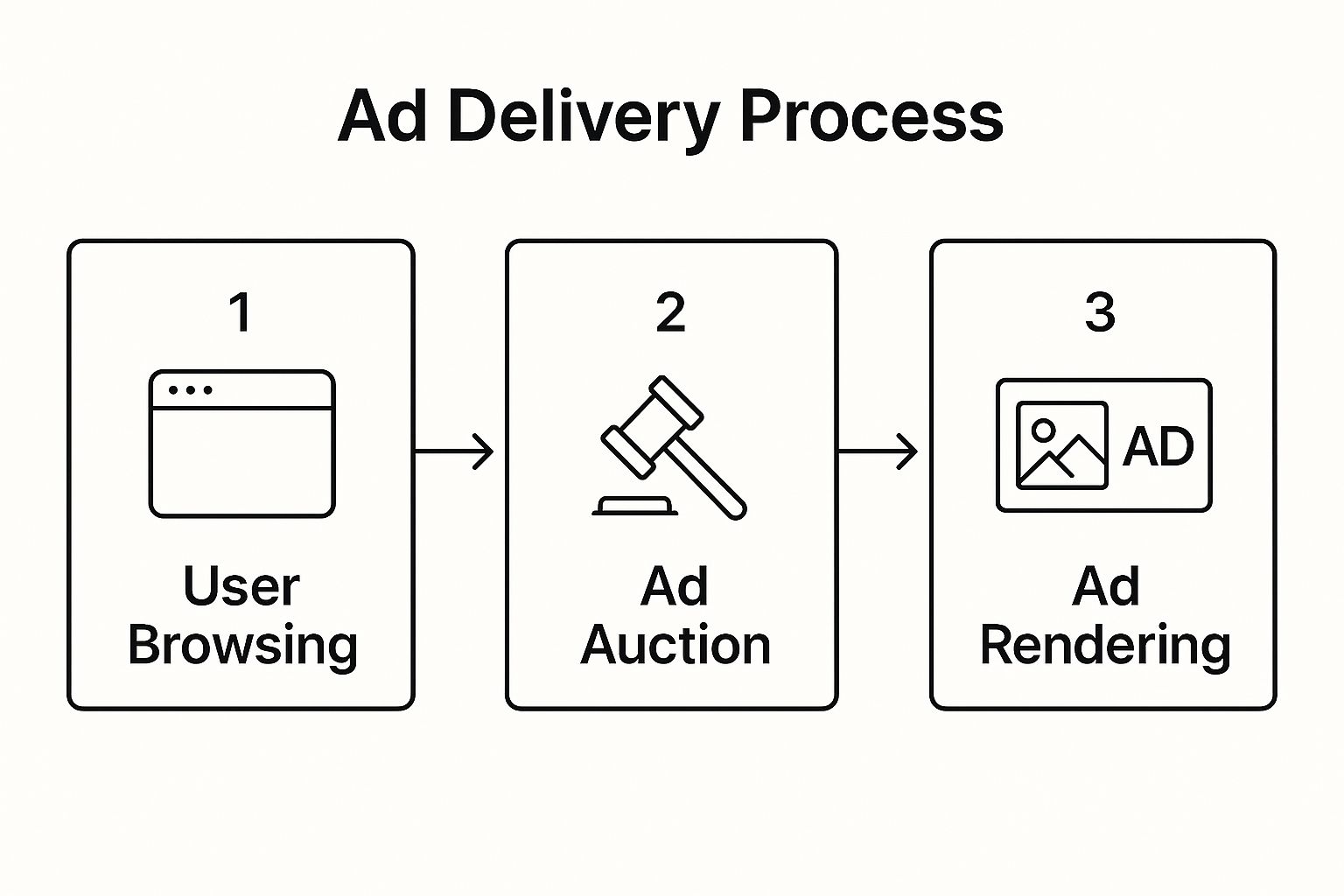What is Display Advertising? A Complete Guide to Boost Your Success

Ever heard of display advertising? You’ve definitely seen it. Think of it as the internet’s answer to the classic billboard. These are the visual, image-based ads you come across on websites, social media, and inside your favourite apps. They stand apart from the simple text ads you see in search results.
What is Display Advertising? Understanding Display Advertising Beyond the Banner

Cast your mind back to the last news article you read or blog you browsed. Those graphical ads popping up in the header, nestled in the sidebar, or embedded right in the content? That’s display advertising in action.
Here’s the key difference: search advertising is reactive. It waits for someone to type a query into a search engine. Display advertising, on the other hand, is proactive. It doesn’t wait to be found. Instead, it puts a brand’s message directly in front of potential customers while they’re busy doing other things online. The goal is to build brand awareness and nudge them towards a future purchase.
This proactive vs. reactive distinction is a big deal. To get a better handle on the reactive side of things, it’s worth exploring how Google PPC works.
This whole system really boils down to three key players:
- Advertisers: These are the brands and businesses wanting to get their products or services out there.
- Publishers: The owners of the websites and apps with ad space up for grabs.
- Ad Networks: Think of these as the matchmakers, like the Google Display Network, connecting advertisers with publishers.
Display Ads vs Search Ads A Quick Comparison
To really grasp the difference, let’s break down how proactive display ads stack up against reactive search ads. They each have their place, but they play very different roles in a marketing strategy.
| Characteristic | Display Advertising | Search Advertising |
|---|---|---|
| User Intent | Passive (browsing content) | Active (searching for something specific) |
| Approach | Proactive (“Push” marketing) | Reactive (“Pull” marketing) |
| Primary Goal | Build brand awareness, create demand | Capture existing demand, drive conversions |
| Ad Format | Visual (images, videos, animations) | Text-based |
| Targeting | Based on demographics, interests, behaviour | Based on keywords and search queries |
| Cost Model | Often CPM (Cost Per Mille/Thousand) | Primarily CPC (Cost Per Click) |
Understanding these fundamental differences is the first step to figuring out which strategy—or which blend of the two—is right for your business.
The Impact on UK Digital Marketing (What is Display Advertising?)
Display advertising is a massive pillar of the UK’s digital marketing scene. You only need to look at the numbers to see its importance. The total digital ad spend in the UK hit a whopping £35.5 billion in 2024, which is a solid 13% jump from the year before.
High-impact formats are really leading the charge. Video display advertising spend, for example, surged by 20% to reach £8.3 billion. It’s clear that businesses are looking for more engaging ways to grab people’s attention, and video is delivering. You can dig into all the details in the full IAB report on UK digital ad market growth.
Display advertising’s true power isn’t just showing an ad; it’s about showing the right ad to the right person at the right time, making a visual impression that text alone cannot achieve. It shifts the goal from just answering a question to creating desire.
What is Display Advertising? The High-Speed Auction Behind Every Ad You See
Ever wondered how an ad for a pair of trainers you just looked at suddenly pops up on a completely different website? It’s not magic. It’s a high-speed, automated auction that happens in the blink of an eye, and it’s the engine powering modern display advertising.
Think of it like an incredibly fast-paced art auction. The moment you start loading a webpage, the available ad space on that page is instantly put up for sale. In milliseconds, advertisers from all over the world place bids to show their ad specifically to you. The highest bidder wins, and their ad appears.
This entire automated process is known as programmatic advertising.
Understanding Real-Time Bidding
The core technology making this lightning-fast auction possible is called Real-Time Bidding (RTB). It’s the mechanism that allows advertisers to buy and sell ad impressions one by one, as they happen. This is a massive shift from the old days of buying ad space in bulk, often months in advance.
RTB takes place on digital marketplaces called ad exchanges. These platforms connect advertisers who want to buy ad space with publishers who have it to sell. Huge networks like the Google Display Network are essentially vast webs of websites and apps all participating in these auctions, making it possible to reach audiences on a massive scale.
The sheer scale of this automated approach is reshaping marketing budgets. In fact, programmatic display advertising in the UK is projected to hit £23.19 billion in 2025, which is almost double the combined spend of Germany and France. This just goes to show how central this data-driven technology has become. You can find out more in these programmatic ad spend projections.
What is display advertising today? It’s an intelligent system where advertisers don’t just buy space on a website; they buy the chance to reach a specific person, at a specific moment, for a price determined in real time.
The infographic below shows this journey from a user’s perspective.

The flow is simple: you browse a site, the ad auction kicks off behind the scenes, and the winning ad is displayed on your screen—all happening faster than the page itself can load.
What is Display Advertising? Choosing the Right Visuals for Your Campaign

Long gone are the days when display advertising was just a simple static banner slapped at the top of a webpage. The modern creative toolbox is absolutely packed with different formats, and each one is built to grab attention in its own unique way. Picking the right one is a huge part of your campaign’s success.
Of course, the classic formats are still a massive part of the ecosystem. Think of these as the reliable workhorses of display advertising, coming in standard sizes that are recognised right across the web.
- Leaderboards: Those wide, rectangular ads you often see greeting you at the top of a page.
- Skyscrapers: Tall, skinny ads that usually run down the side of the main content.
- Medium Rectangles (MPUs): Super versatile square or rectangular ads you can slot right into the middle of an article.
These formats are brilliant for building broad brand awareness and just keeping your message front and centre in people’s minds. They’re cost-effective and supported by pretty much every website you’ll find in an ad network.
Moving Beyond Static Images (What is Display Advertising?)
While those traditional banners definitely have their place, today’s display advertising offers far more dynamic options that can drive seriously higher engagement. This is where rich media ads come into play, designed from the ground up for interaction.
Rich media ads ditch the static image and bring in elements that users can actually engage with. We’re talking about things like a mini-game, a product carousel they can swipe through, or even a form they can fill out without ever leaving the page.
Their interactive nature makes them incredibly good at capturing and holding someone’s attention, which naturally leads to much better engagement rates. An e-commerce brand, for example, could use a rich media ad to show off multiple products, much like the visual experience you get when you’re mastering Google Shopping ads.
What is display advertising’s secret weapon? It’s the ability to tell a story visually. Rich media and video formats transform a simple ad from a static billboard into an interactive experience, inviting the user to become part of the narrative rather than just a passive observer.
The Unstoppable Rise of Video Ads
Video has completely taken over online content, and advertising is no different. We know from research that powerful imagery and good storytelling are incredibly persuasive, which makes video the perfect medium for a display campaign.
Generally, video ads fall into two main camps:
- In-Stream Video Ads: These are the ads you see before, during, or after a video you’ve actually chosen to watch, like on YouTube. They catch a highly engaged audience, but they have to be compelling enough to stop people from hitting that “skip” button.
- Out-Stream Video Ads: These ads pop up within non-video content, like inside a news article or a social media feed. They often start playing automatically (on mute) as you scroll past, offering a less intrusive way to deliver a video message.
Both formats are exceptional at telling a story and showing a product or service in action. They’re perfect for campaigns that want to create an emotional connection with the audience or need to explain a more complex idea, making them a seriously powerful tool for any modern advertiser.
What is Display Advertising? How to Find and Reach Your Ideal Audience
Creating a stunning ad is only half the battle. Its true power is unlocked when it reaches the right people, at the right time. This is where the magic of display advertising targeting comes in. It’s the difference between shouting your message from a rooftop to a random crowd and whispering it directly into the ear of someone you know is ready to listen.
Think of it like this: you could stick a flyer on every car in a massive car park, hoping for the best. Or, you could hand that same flyer directly to someone you’ve just seen looking up your exact services on their phone. Display targeting lets you do the digital version of the latter.
The most straightforward approach, and a classic for a reason, is contextual targeting. This method is beautifully simple: place your ads on websites and pages where the content is directly related to what you’re selling. If you sell high-end kitchen knives, your display ads could pop up on popular food blogs or recipe websites. You’re meeting people who are already in the right frame of mind.
Refining Your Audience with Specific Criteria (What is Display Advertising?)
Beyond the general topic of a page, you can start layering on more specific filters to really zero in on your ideal customer. These layers ensure your budget isn’t wasted on vague guesses, making your campaign much more efficient. Getting this level of focus right is a cornerstone when you’re learning how to start PPC marketing and want to see a real return on your initial investment.
Some of the most common targeting layers include:
- Demographic Targeting: Filtering your audience by criteria like age, gender, parental status, or household income. A brand selling luxury watches, for instance, might target users aged 35+ in higher income brackets.
- Geographic Targeting: This lets you get incredibly local, focusing on users in specific locations – from an entire country right down to a single postcode. A local restaurant would use this to show ads only to people within a five-mile radius.
- Device Targeting: You can choose to show ads only to people on certain devices, like mobile phones, desktops, or tablets. A mobile app developer, for example, would almost exclusively target mobile and tablet users.
The Power of Behavioural and Retargeting
This is where display advertising gets really clever and incredibly effective.
Behavioural targeting uses anonymous data about a user’s past online activities—things like the websites they’ve visited, articles they’ve read, and products they’ve browsed—to build up a picture of their interests. An advertiser can then target users who fit a specific interest profile, like “frequent international travellers” or “home renovation enthusiasts,” no matter what website they happen to be on at that moment.
But the most powerful strategy in this category has to be retargeting (also known as remarketing). This tactic lets you reconnect with users who have already visited your website but left without taking action. By showing them targeted ads as they browse other sites, you gently remind them of what they were looking at, encouraging them to come back and finish that purchase. It’s a hugely effective way to re-engage warm leads who have already shown a clear interest in your brand.
What is Display Advertising? Weighing the Benefits and Common Pitfalls

Let’s be honest, no marketing channel is a silver bullet, and display advertising is certainly no exception. Getting your head around its strengths and weaknesses is the key to setting realistic expectations and building a strategy that actually works. When you get it right, the upside is massive.
One of the biggest draws is its incredible reach and scale. Display networks cover millions upon millions of websites, giving you the power to introduce your brand to enormous new audiences. This makes it an absolute beast for top-of-funnel marketing, where your main goal is simply getting your name out there and building recognition.
On top of that, the visual nature of display ads opens up a world of storytelling and creativity. You can use powerful images, slick animations, and engaging video to connect with people on an emotional level, communicating your brand’s personality in a way that plain old text ads just can’t match.
Navigating the Potential Downsides
However, it’s not all smooth sailing. You need to be aware of the common hurdles you’ll face. The most famous challenge is “banner blindness” – a real phenomenon where people have become so used to seeing ads that their brains just subconsciously filter them out. This makes having standout creative and sharp targeting more important than ever.
Another thing to keep in mind is that display ads nearly always have a lower click-through rate (CTR) when you compare them to search ads. This is completely natural; you’re essentially interrupting someone’s browsing session rather than directly answering a question they just typed into Google. Success here is often measured by impressions and brand lift, not just clicks. Understanding this is a crucial part of maximising your ROI with Google Pay Per Click advertising strategies.
Despite these challenges, advertiser confidence in the UK’s online display ad sector is strong. Spending shot up by a robust 15.1% year-on-year in 2024, easily outpacing general economic growth. This really highlights the value businesses are placing on visual, targeted campaigns. You can dig into the details in the latest UK advertising spend forecast.
By balancing the immense potential for brand awareness against challenges like banner blindness, you can put together a display advertising plan that sidesteps the pitfalls and delivers real, tangible results for your business.
What is Display Advertising? Actionable Steps for a Winning Display Campaign
Putting theory into practice is where a display advertising strategy really starts to deliver. A winning campaign isn’t just about clever targeting; it’s built on a solid, step-by-step approach that covers everything from creative design right through to performance analysis.
First things first, you need crystal-clear objectives. Are you trying to get your brand name out there, pull more traffic to your website, or make direct sales? Your answer will shape every other decision you make, especially the metrics you’ll use to track success. A brand awareness campaign, for example, will live and die by its impressions, while a sales-focused campaign is all about conversions.
Design and Optimise Your Creatives
Once your goals are sorted, it’s time to focus on compelling ad design. Your visuals need to grab attention instantly, your branding has to be consistent, and your copy must be sharp and to the point. Most importantly, every single ad needs a powerful call-to-action (CTA). Tell people exactly what to do next, whether it’s “Shop Now” or “Learn More.”
And remember, your first attempt is rarely your best. You have to implement A/B testing by creating a few different versions of your ad. Try testing things like:
- Headlines
- Images or video clips
- CTA button colours
- Ad copy
By constantly checking which version performs best, you can fine-tune your campaign for better results over time. This kind of iterative improvement is a cornerstone of many effective marketing strategies that drive real, sustained growth.
Ensure a Seamless User Journey (What is Display Advertising?)
The user’s experience doesn’t stop after they click. Dropping someone on your generic homepage after they’ve clicked a specific ad is a recipe for confusion and high bounce rates. You need to send them to a dedicated landing page that directly reflects the ad’s message and offer. This creates a smooth, logical journey that dramatically boosts your chances of getting that conversion.
A great display ad gets the click, but a great landing page secures the conversion. The transition from ad to page should feel like a natural next step, not a jarring detour.
By carefully managing each of these elements—from setting clear goals and optimising your creatives to perfecting the landing page experience—you can build a display campaign that doesn’t just capture attention but also delivers measurable, meaningful results.
Got Questions About Display Advertising?
Dipping your toes into display advertising can feel a bit daunting at first. It’s a big world, and it’s natural to have questions. Let’s clear up a few of the most common ones we hear from businesses just getting started.
How Much Should I Budget for Display Ads in the UK?
There’s no magic number here – it all comes down to what you’re trying to achieve. The cost really boils down to two main models:
- Cost Per Thousand Impressions (CPM): With this model, you pay a flat rate for every 1,000 times your ad gets shown. It’s perfect for brand awareness campaigns where your main goal is simply getting your name out there and being seen by as many relevant people as possible.
- Cost Per Click (CPC): Just like it sounds, you only pay when someone actually clicks your ad. This is the go-to for campaigns where the goal is to drive traffic, generate leads, or make direct sales.
A small business in the UK might kick things off with a modest budget just to test the waters. A bigger brand, on the other hand, could be investing a serious amount. The key is to match your spend to your objective. Are you playing the long game for visibility (CPM) or chasing immediate actions (CPC)?
Is Display Advertising Still Worth It? (What is Display Advertising?)
Absolutely, but you have to be smart about it. The old fear of “banner blindness” – where people just tune out ads – is a real risk if you’re just blasting generic banners at everyone. But modern display advertising has moved way beyond that.
Success today isn’t about shouting the loudest; it’s about relevance. The real power of display advertising now is in its precision. It’s about using clever targeting, eye-catching creative, and strategic retargeting to have a quiet word with the right person at exactly the right time.
When you get it right, it’s a fantastically effective way to build your brand and bring interested customers back into the fold.
How Does the Google Display Network Relate to Programmatic Advertising?
This one trips a lot of people up, but it’s simpler than it sounds. Let’s use an analogy.
Imagine you want to hand out flyers all over town.
The Google Display Network (GDN) is like a massive network of approved noticeboards. Think of all the shops, community centres, and cafes that have agreed to let you pin up your flyer. It’s a huge, specific place to show your ads.
Programmatic advertising, on the other hand, is the super-smart, automated delivery service. This service takes your flyer and, in a split second, decides which exact noticeboard is the best one to use at that very moment to reach the perfect person. It’s the intelligent process that buys the ad space for you, not just on the GDN but across many other networks too.
So, the GDN is a major destination for your ads, while programmatic is the high-tech vehicle that gets you there—and to countless other places—with maximum efficiency.
Ready to stop guessing and start getting real results from your digital ads? The team of experts at PPC Geeks can build a data-driven display advertising strategy to boost your brand awareness, drive quality traffic, and increase sales. Find out how we can help.
Author
Search Blog
Free PPC Audit
Subscribe to our Newsletter
The Voices of Our Success: Your Words, Our Pride
Don't just take our word for it. With over 100+ five-star reviews, we let our work-and our satisfied clients-speak for us.
"We have been working with PPC Geeks for around 6 months and have found Mark and the team to be very impressive. Having worked with a few companies in this and similar sectors, I rate PPC Geeks as the strongest I have come across. They have taken time to understand our business, our market and competitors and supported us to devise a strategy to generate business. I value the expertise Mark and his team provide and trust them to make the best recommendations for the long-term."
~ Just Go, Alasdair Anderson
